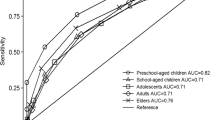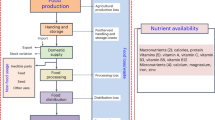Abstract
In 2006, the WHO published a framework for calculating the desired level of fortification of any micronutrient in any staple food vehicle, to reduce micronutrient malnutrition. This framework set the target median nutrient intake, of the population consuming the fortified food, at the 97.5th percentile of their nutrient requirement distribution; the Probability of Inadequacy (PIA) of the nutrient would then be 2.5%. We argue here that the targeted median nutrient intake should be at Estimated Average Requirement (50th percentile), since the intake distribution will then overlap the requirement distribution in a population that is in homeostasis, resulting in a PIA of 50%. It is also important to recognize that setting the target PIA at 2.5% may put a sizable proportion at risk of adverse consequences associated with exceeding the tolerable upper limit (TUL) of intake. This is a critical departure from the WHO framework. For a population with different age- and sex-groups, the pragmatic way to fix the fortification level for a staple food vehicle is by achieving a target PIA of 50% in the most deprived age- or sex-group of that population, subject to the condition that only a very small proportion of intakes exceed the TUL. The methods described here will aid precision in public health nutrition, to pragmatically determine the precise fortification level of a nutrient in a food vehicle, while balancing risks of inadequacy and excess intake.
This is a preview of subscription content, access via your institution
Access options
Subscribe to this journal
Receive 12 print issues and online access
$259.00 per year
only $21.58 per issue
Buy this article
- Purchase on Springer Link
- Instant access to full article PDF
Prices may be subject to local taxes which are calculated during checkout




Similar content being viewed by others
Data availability
This was a secondary data analysis, based on a dummy dataset generated out of original data from the National Nutrition Monitoring Bureau (NNMB) 2012. The NNMB data are the property of the Indian Council of Medical Research - National Institute of Nutrition, Hyderabad, India.
References
WHO, FAO. Guidelines on Food Fortification with Micronutrients. WHO Press; Geneva, 2006.
Kimura AH. Solving hidden hunger with fortified food. In Hidden Hunger: Gender and the Politics of Smarter Foods. Cornell University Press, 2013 http://www.jstor.org/stable/10.7591/j.ctt1xx5n3.8. Accessed 5 April 2022.
Jiang L, Wang K, Lo K, Zhong Y, Yang A, Fang X, et al. Sex-specific association of circulating ferritin level and risk of type 2 diabetes: A dose-response meta-analysis of prospective studies. J Clin Endocrinol Metab. 2019;104:4539–51.
Lee DH, Kang SK, Choi WJ, Kwak KM, Kang D, Lee SH, et al. Association between serum ferritin and hypertension according to the working type in Korean men: the fifth Korean National Health and nutrition examination survey 2010-2012. Ann Occup Environ Med. 2018;30:40.
Ghosh S, Thomas T, Kurpad AV, Sachdev HS. Is iron status associated with markers of non-communicable disease in Indian children? Res Sq. 2021. https://doi.org/10.21203/rs.3.rs-1136688/v1.
Carriquiry AL. Assessing the prevalence of nutrient inadequacy. Public Health Nutr. 1999;2:23–33. https://doi.org/10.1017/s1368980099000038. MarPMID: 10452728
Sachdev HS, Porwal A, Acharya R, Ashraf S, Ramesh S, Khan N, et al. Haemoglobin thresholds to define anaemia in a national sample of healthy children and adolescents aged 1-19 years in India: A population-based study. Lancet Glob Health. 2021;9:e822–e831.
Institute of Medicine. Dietary Reference Intakes. The essential guide to nutrient requirements. Washington (DC): National Academies Press;2006.
Allen LH, Carriquiry AL, Murphy SP. Perspective: Proposed harmonized nutrient reference values for populations. Adv Nutr. 2020;11:469–83.
Kurpad AV, Ghosh S, Thomas T, Bandyopadhyay S, Goswami R, Gupta A, et al. Perspective: When the cure might become the malady: the layering of multiple interventions with mandatory micronutrient fortification of foods in India. Am J Clin Nutr. 2021;114:1261–6.
Kurpad AV. Amino Acid Imbalances: Still in the Balance. J Nutr. 2018;148:1647–9.
Kärberg K, Forbes A, Lember M. Raised dietary Zn:Cu ratio increases the risk of atherosclerosis in type 2 diabetes. Clinical Nutrition ESPEN, https://doi.org/10.1016/j.clnesp.2022.05.013.
National Nutrition Monitoring Bureau (NNMB). Diet and Nutritional Status of Rural Population, Prevalence of Hypertension and Diabetes Among Adults and Infant and Young Child Feeding Practices‑ Report of Third Repeat Survey. Hyderabad, India: National Institute of Nutrition, Indian Council Med Res. 2012.
Indian Council of Medical Research / National Institute of Nutrition. Nutrient Requirements for Indians. Department of Health Research, Ministry of Health and Family Welfare, Government of India. 2020.
Gera T, Sachdev HS, Boy E. Effect of iron-fortified foods on hematologic and biological outcomes: systematic review of randomized controlled trials. Am J Clin Nutr. 2012;96:309–24.
WHO. Guideline: fortification of food-grade salt with iodine for the prevention and control of iodine deficiency disorders. Geneva: World Health Organization; 2014.
Ministry of Health and Family Welfare (MoHFW), Government of India, UNICEF and Population Council. Comprehensive National Nutrition Survey (CNNS). National Report 2016–2018. New Delhi, India: MoHFW, Government of India, UNICEF and Population Council; 2019.
Cyriac S, Haardörfer R, Neufeld LM, Girard AW, Ramakrishnan U, Martorell R, et al. High coverage and low utilization of the Double Fortified Salt program in Uttar Pradesh, India: Implications for program implementation and evaluation. Curr Dev Nutr. 2020;4:nzaa133 https://doi.org/10.1093/cdn/nzaa133.
Lewis J. Codex nutrient reference values. Rome. FAO, WHO. 2019.
Quevedo MR, Price GM, Halliday D, Pacy PJ, Millward DJ. Nitrogen homoeostasis in man: diurnal changes in nitrogen excretion, leucine oxidation and whole body leucine kinetics during a reduction from a high to a moderate protein intake. Clin Sci (Lond). 1994;86:185–93.
Kurpad AV, Regan MM, Raj T, El-Khoury A, Kuriyan R, Vaz M, et al. Lysine requirements of healthy adult Indian subjects receiving long-term feeding, measured with a 24-h indicator amino acid oxidation and balance technique. Am J Clin Nutr. 2002;76:404–12.
WHO, FAO, UNU. Protein and Amino Acid Requirements in Human Nutrition: Report of a Joint WHO/FAO/UNU Expert Consultation. Geneva, Switzerland: World Health Organization; 2007. WHO technical report series 935.
Heinig MJ, Nommsen LA, Peerson JM, Lonnerdal B, Dewey KG. Energy and protein intakes of breast-fed and formula-fed infants during the first year of life and their association with growth velocity: The DARLING study. Am J Clin Nutr. 1993;58:152–61.
Walter PB, Fung EB, Killilea DW, Jiang Q, Hudes M, Madden J, et al. Oxidative stress and inflammation in iron-overloaded patients with beta-thalassaemia or sickle cell disease. Br J Haematol. 2006;135:254–63.
Zimmermann MB, Fucharoen S, Winichagoon P, Sirankapracha P, Zeder C, Gowachirapant S, et al. Iron metabolism in heterozygotes for hemoglobin E (HbE), alpha-thalassemia 1, or beta-thalassemia and in compound heterozygotes for HbE/beta-thalassemia. Am J Clin Nutr. 2008;88:1026–31.
Paganini D, Zimmermann MB. The effects of iron fortification and supplementation on the gut microbiome and diarrhea in infants and children: A review. Am J Clin Nutr. 2017;106:1688S–1693S.
Institute of Medicine (US) Panel on Micronutrients. Dietary Reference Intakes for Vitamin A, Vitamin K, Arsenic, Boron, Chromium, Copper, Iodine, Iron, Manganese, Molybdenum, Nickel, Silicon, Vanadium, and Zinc. National Academies Press (US), Washington DC; 2001.
Simcox JA, McClain DA. Iron and diabetes risk. Cell Metab. 2013;17:329–41.
Ford ES, Cogswell ME. Diabetes and serum ferritin concentration among U.S. adults. Diabetes Care. 1999;22:1978–83.
Kim YE, Kim DH, Roh YK, Ju SY, Yoon YJ, Nam GE, et al. Relationship between serum ferritin levels and dyslipidemia in Korean adolescents. PLoS One. 2016;11:e0153167.
Acknowledgements
HSS, TT and AVK are recipients of the Wellcome Trust/Department of Biotechnology India Alliance Clinical/Public Health Research Centre Grant # IA/CRC/19/1/610006.
Author information
Authors and Affiliations
Contributions
SG, HSS and AVK conceived the idea, SG and TT conducted all statistical analyses; all authors guided the analyses and were involved during drafting and approval of the final manuscript.
Corresponding authors
Ethics declarations
Competing interests
HSS is a member of the World Health Organization Nutrition Guidance Expert Advisory Subgroup on Diet and Health. HSS and AVK are members of Expert Groups of the Ministry of Health and Family Welfare on Nutrition and Child Health, the National Technical Board on Nutrition of the Niti Aayog, Government of India and the Food Standards and Safety Authority of India. KMN is the Chairperson of the FSSAI Scientific Panel on Labelling, Claims and Advertisements, and a member of FSSAI Expert Committee 2 for Approval of Non-specified Food and Food Ingredients and a member of the FSSAI Scientific Panel on Nutrition and Fortification.
Additional information
Publisher’s note Springer Nature remains neutral with regard to jurisdictional claims in published maps and institutional affiliations.
Supplementary information
Rights and permissions
Springer Nature or its licensor holds exclusive rights to this article under a publishing agreement with the author(s) or other rightsholder(s); author self-archiving of the accepted manuscript version of this article is solely governed by the terms of such publishing agreement and applicable law.
About this article
Cite this article
Ghosh, S., Thomas, T., Pullakhandam, R. et al. A proposed method for defining the required fortification level of micronutrients in foods: An example using iron. Eur J Clin Nutr 77, 436–446 (2023). https://doi.org/10.1038/s41430-022-01204-4
Received:
Revised:
Accepted:
Published:
Issue Date:
DOI: https://doi.org/10.1038/s41430-022-01204-4
This article is cited by
-
The Need for Food Fortification With Zinc in India: Is There Evidence for This?
Indian Pediatrics (2023)



